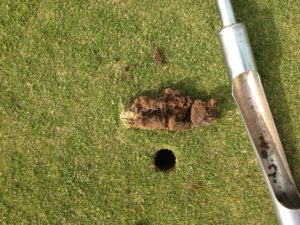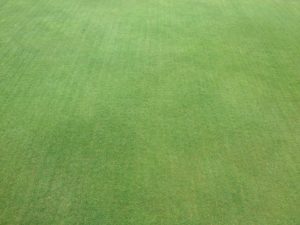In this, our third article on organic matter, agronomist, Charles Henderson will cover the complex subject of its reduction. Organic matter, in general, is on the increase. Therefore, this makes the reduction of organic matter in greens, relevant to over 90% of us who are involved in managing golf (and bowling) greens, an extremely important subject.
From your own experience, many of you will look back and congratulate yourselves on the reduction of organic matter in your greens. As course managers, this is commonly experienced as an inherited issue upon commencement of a new role.
To what extent do we reduce it? At what rate did we reduce it? These are parameters often unknown. The impact of climate and the greens construction are seldom factored in to these achievements. This is significant, in the sense that there is no exact formula. As outlined within parts 1 and 2 of our organic matter articles, some greens are prone to quicker organic matter accumulation than others.
To assume what worked historically at one venue may be as effective at another, may be to assume incorrectly.
What % of Organic Matter Are You Starting From?
Very rarely are the starting points or the rates of organic matter accumulation the same.
In order to formulate a bespoke programme for organic matter reduction, an accurate interpretation of the existing situation is required. From the data accumulated, we are able to determine the efficacy of outlined programmes with regards to organic matter reductions.

Part-Filled 10mm Hollow-Core Hole – Common Place at Renovations
At 3-7% in 0-20mm and 20-40mm
If you are within this range it would be fair to say the hard work is done and the focus is increasingly on dilution of the organic matter in the upper profile.
Dilution vs Removal of organic matter – American research is, encouragingly, realising high rates of efficacy, via solid-tining and sand dressing programmes as opposed to the more conventional hollow coring, widely adopted throughout the UK and Europe.
Relying on dilution alone to manage organic matter requires a careful approach. Sand-based greens, effective pipe drainage or well-structured underlying soil, combined with already low organic matter, is required for this strategy. Trying to implement dilution alone on greens already high in organic matter or prone to accumulation at an accelerated rate is likely to fail, unless sand topdressing rates are astronomically high.
It is fair to say that, at these levels, the need for aggressive deep scarification and large diameter hollow-tining, for the purpose of organic matter management, will result in unnecessary time and resources being spent on renovations.

Considered for Dilution
Reduction of organic matter at this level should be one of the key objectives, although the necessity for the speed of reduction will lessen somewhat compared to that where higher amounts of organic matter are found. The vast majority of clubs at this level tend to select a more gradual reduction programme.
There are a range of effective strategies at this level, including hollow coring, deep scarification and/or sand-injection, which normally provide a reasonable level of reduction. Where clubs have become more relaxed at this level of organic matter, the use of smaller blades/tines with larger spacing, in order to reduce disruption to play, is common. In many cases, this results in an unwanted organic matter increase.
The dilution strategy, once organic matter is at this level, is somewhat unknown, with mixed results being observed to date. From the results observed, dilution alone at this level will be insufficient to ensure a healthy level of reduction is achieved, dependent upon the extent to which it is implemented and on the type of green.
At 12-17% in 0-20mm and 20-40mm
When organic matter has reached this level, its reduction must be one of the key objectives in order to reduce exposure to the negative impact of organic matter.
A great deal of urgency is required to achieve reduction at this stage as, at this level of organic matter, greens are more prone to further increases, due to them remaining saturated and anaerobic for longer periods throughout the year, (as outlined in part 2 of our organic matter series).
The dilution strategy at this stage is, in our professional opinion, ineffective and will not reduce organic matter as suitable rates, if at all. Conventional forms of renovation programmes, at this rate, achieve only moderate to slow reduction and, in some cases, can see increases.
More often than not, when greens have reached this stage, notable renovation programmes are required. These comprise over and above average treatments. New technology, such as sand injection, has made these operations easier and less disruptive. Details such as tine sizes, blade width and spacing become increasingly important at this level of organic matter, when its removal, in combination with dilution, is essential.
At > 15% in 0-20mm and 20-40mm
On reaching this stage, the reduction of organic matter will not only be the highest priority but will present one of its biggest maintenance challenges, namely, its successful and sustained reduction.
Prior to detailing the best working practices on reaching this level of organic matter, let us first rule out ineffective methods. Micro-tining, dilution only and even conventional hollow coring and scarification will produce extremely modest to completely wasteful results.
Double treatment – The details of renovations will be imperative on reaching this stage of organic matter development. Nothing short of 14-16mm tine sizes should be considered, and 2.5-3mm blade width on scarification units will be essential in order to achieve the necessary percentage of surface impact. Single treatment (hollow core) at the conventional 2 x annually will have a marginal effect and will be slow to reduce the organic matter back to desired or even acceptable levels. Sand injection treatments have proved effective in the rate of reduction, and should be considered in these cases.

One week after double treatment
Retaining expert advice in working through such process will be critical as, if implemented poorly, surface disruption is often more severe than necessary.
At > 20% organic matter – surface renewal programmes – where organic matter levels of > 20% are present, serious consideration should be given to surface renewal programmes.

Not suitable for dilution
In Summary
Renovation, sand dressing and aeration treatments represent some of the most controversial management practices implemented on the golf course.
These practices also represent some of the most important and essential practices for the promotion of plant health and quality, year round, playing surfaces.
Whether or not implementing these practices is sufficient or excessive, knowing the necessity for them is fundamental to any maintenance programme.
Through close monitoring, we are now working with many clubs on reducing unnecessary operations, thanks to changes made in previous years.
Organic Matter Testing Service Offer
| No. of | Greens | Cost | Interpretation Report | (if required) | |||||||||||||||||||||||||||||||||||||||||||
| 1 Green | £56.00 | £50.00 | |||||||||||||||||||||||||||||||||||||||||||||
| 3 Greens | £168.00 | £50.00 | |||||||||||||||||||||||||||||||||||||||||||||
| 6 Greens | £336.00 | £100.00 | |||||||||||||||||||||||||||||||||||||||||||||
| 9 Greens | £458.00 | £150.00 |
Contact us